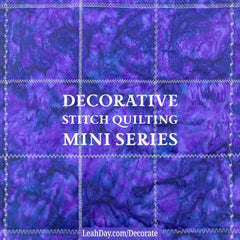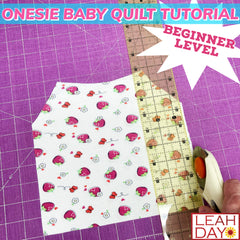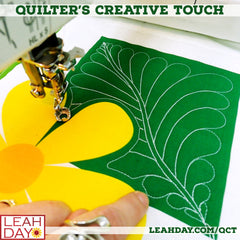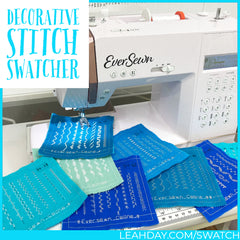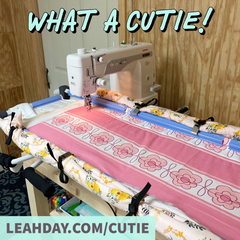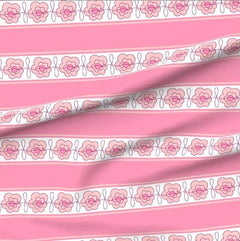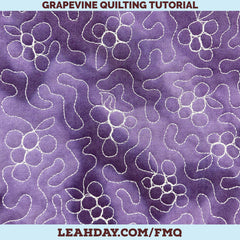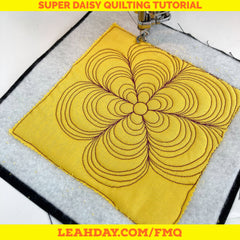Sewing and quilting can put a lot of wear and tear on your sewing machine. Let's learn how to take care of our machines by cleaning out the bobbin area and oiling it so it stays in great working order.

See how I clean and oil my home sewing machine, the Bernina 1230 in this quilting tutorial:
Tools and Supplies from this Quilting Tutorial:
How to Clean your Sewing Machine
It's so much fun to keep sewing and quilting, but your machine is going to work so much better of you stop and brush it out occasionally. Check your sewing machine manual to see if you can remove any plates or pieces to the top or bobbin area of your machine easily.
Once you remove the needle plate, you may find a scary surprise - dust bunnies!

These are not the nice the nice kind of bunny to sew. Dust bunnies like the ones that built up in my machine above can break a sewing machines by locking up the moving parts.
At the very least, they can cause an unsightly mess when the glob of lint gets trapped in our thread and stitched to the back of a quilt.
As you can see in the video, I can remove the needle plate, and pull out the bobbin and rotary hook in my machine. This is really helpful for accessing all the nooks and crannies in the bobbin area, which is prone to filling with lint, especially when quilting fluffy quilts.
I use a small brush to catch all the bits of lint and stray threads that fill in this area. Apply a single drop of oil to the end of your brush and it will catch even more lint and help you nab those tiny bits that are almost impossible to remove.
If you have a vacuum cleaner handy with tiny vacuum attachments, by all means give it a try. I've always found this clunky and challenging to use, and I didn't think it worked as good as just brushing the lint out by hand with a small brush.
NEVER Use Can of Air to Clean your Sewing Machine
Blowing air into your machine will push the lint further inside where you cannot brush it out. The lint needs to be removed, not just blown out of sight.
Can of Air also includes chemicals and oils that can combine with the oily lint inside your machine to create a cement-like sludge. Yes, this will lock up your machine and stop it from working permanently. All of the sewing machine repairmen I've spoken to over the years have warned repeatedly against using Can of Air because they have seen numerous sewing machines ruined by it.
How Often Should You Clean Your Sewing Machine?
How much do you sew or quilt? If you're a weekend quilter, it's a good idea to start the weekend with a clean machine. Either get into the habit of brushing out your sewing machine before you put it away for the week, or starting the weekend with a good cleaning instead. That habit will ensure you're always sewing with a clean, well oiled machine and you'll likely have fewer thread breaks or stitching issues along the way.

If you sew and quilt more often, my rule of thumb is every 2 bobbin changes. If you've emptied two full bobbins of thread, that is a lot of distance you've put on the machine and it's likely going to be pretty dirty.
However, this can be dramatically different depending on what type of thread you're using inside your machine. Back when I sewed 60 garments per week, I'd brush out my machine multiple times a day because I was using cheap cotton / polyester blended serger thread that was terribly linty. I broke two sewing machines before I learned to check the bobbin area multiple times a day because the lint built up so quickly.
If you are using higher quality, low lint thread like Isacord Polyester thread or Aurifil Mako Cotton, you're not going to experience nearly this volume of lint build up, but it's still a good habit to keep your machine clean and running smoothly.
What Else Do You Change When Cleaning Your Machine?
I also change my needle when I clean out the machine. Yes, when I'm quilting a lot that could be multiple needles changed out per week!
Growing up, I don't remember ever changing the needle or cleaning out the sewing machine we had in our house. The same rusty, bent needle stayed in the machine for years and you can imagine how great that machine stitched as a result.
These days, I buy sewing machine needles in bulk and change often. You'd be surprised just how many thread breaks and weird stitch issues are caused by a dull, bent, or slightly burred needle. It's a cheap, easy thing to change and can make a huge difference in your sewing and quilting experience.
Where Do You Oil Your Sewing Machine?

All sewing machines are different and can require oiling in different places. The first place to check is your sewing machine manual which should include a diagram for the spots to hit with oil.
If you don't have a sewing machine manual or it doesn't include any suggestions for oiling, here's my general advice. I apply 1 drop of oil to the following places on my sewing machine:
- The rotary hook - This is the thing that spins sideways on a side loading bobbin, or underneath the plastic piece in a top loading bobbin.
- The little bars that move behind the hook - If you can reach the bars that shift horizontally in the base of the machine, 1 drop of oil won't hurt.
- The needle bar - This is the bar that holds your needle and moves up and down inside your machine.
I've also heard advice from vintage sewing machine enthusiasts to oil "everything that moves" and I think that's a good rule of thumb too.
Only Use Actual Sewing Machine Oil in Your Sewing Machine
Never use 3-in-1 oil, WD40, or anything other than clearly labeled Sewing Machine Oil in your machine. Other oils tend to dry out and go gummy. Imagine chewing gum wrapped around the needle bar or stuck in the bobbin case of your sewing machine. That's basically what these other oils will do.
I recommend (Affiliate) Sew Rite sewing machine oil. I purchased a big bottle back in 2005 from a sewing machine dealer and keep it stored in a dark cabinet. I pour a bit into a micro tip bottle and keep the small bottle next to my machine so it's quick and convenient to oil anytime it's needed.
With so many small details, it may feel intimidating to clean and oil your sewing machine yourself. I promise, you can do this yourself and you should give it a try. The more often you clean out your machine, the more confident you will feel and the better you will understand how these beautiful machines work.
Let's go quilt,
Leah Day

